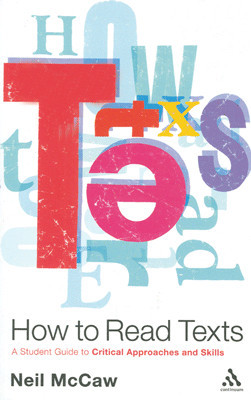How to Read Texts: A Student Guide to Critical Approaches and Skills 1st Edition(English, Paperback, Neil McCaw)
Quick Overview
Product Price Comparison
How to Read Texts introduces key critical approaches to literary texts and offers a practical introduction for students developing their own critical and close-reading skills. Written in a lively, jargon-free style, it explains critical concepts, approaches and ideas including: Debates around critical theory The role of history and context The links between creativity and criticism The relationship between author, reader and text. Practical examples, readings, exercises and checkpoints help students to work on their own readings of both primary and secondary texts and to explore the links between critical and creative writing. The book enables students to gain confidence in their critical readings of a variety of texts and encourages them to challenge the assumptions behind other critics readings. How to Read Texts is an indispensable guide for any English student who wants to develop their reading of literary and critical texts. Table of Contents Introduction: Why read about how to read? What is a text? What is reading? Beginning from where you are - finding your critical voice Reading objectively? The inevitability of bias Limitations on reading Using biases and preconceptions The undergraduate questionnaire The creative critic Why are we talking about creativity in a book about reading? Different types of reader: critic vs. writer Criticism and critical theory Creativity and criticism Critical/creative reading: Edgar Allan Poe, The Tell-Tale Heart Intervening in texts Close reading What is close reading? A history of close reading Creatively exploring close reading Critical reading: William Blake, The Tyger Biography and authorship Introduction The role of the author Theories of the author Theories of reading Reception theory The significance of biography The limitations of author-centred approaches Healthy scepticism Creative exploration: biography and authorship Critical reading: Charlotte Bronte, Jane Eyre History and contexts Reading contexts Types of context Genre Literary history Reading genre and literary history: drawbacks History: cultural/social/political The significance of history Using history Marxism New Historicism Feminist criticism Post-colonial criticism The weaknesses of historical readings Benefits of historical readings Creative exploration: history and contexts Critical reading: History in Toni Morrisons Beloved Critical theory Introduction What is critical theory? A very short history Ways of reading theory The what is literature? debate The effects of theory The achievements of theory Approaching theoretical criticism: a way through the maze Reading theory 1: Freud, Civilization and its Discontents Reading theory 2: de Lauretis, Upping the Anti [sic] in Feminist Theory Critical reading: Shakespeares Macbeth Creative exploration: critical theory Conclusion: Unveiling the self-conscious critic The undergraduate questionnaire revisited Reading as exploration Edgar Allan Poe, The Tell-Tale Heart William Blake, The Tyger Arthur Conan Doyle, The Man with the Twisted Lip Notes Bibliography Index


